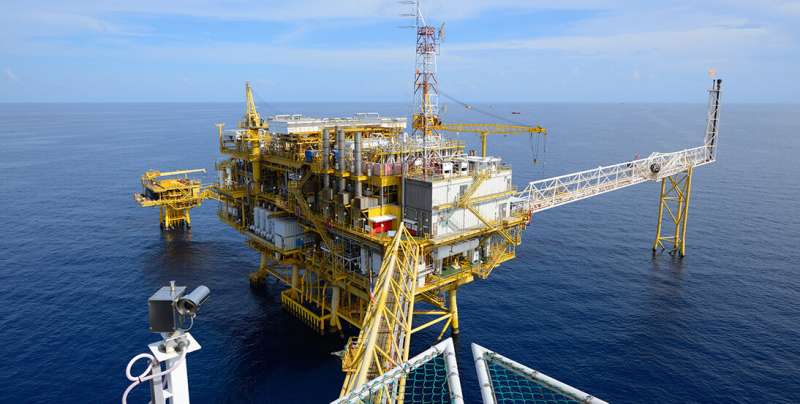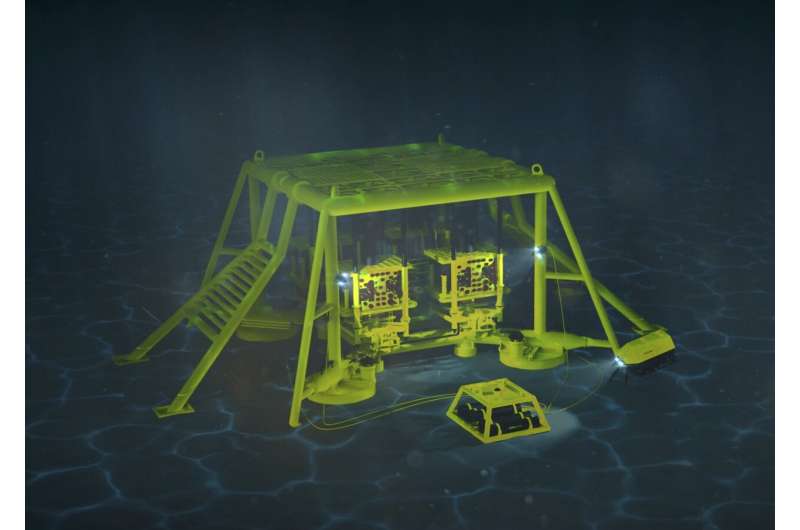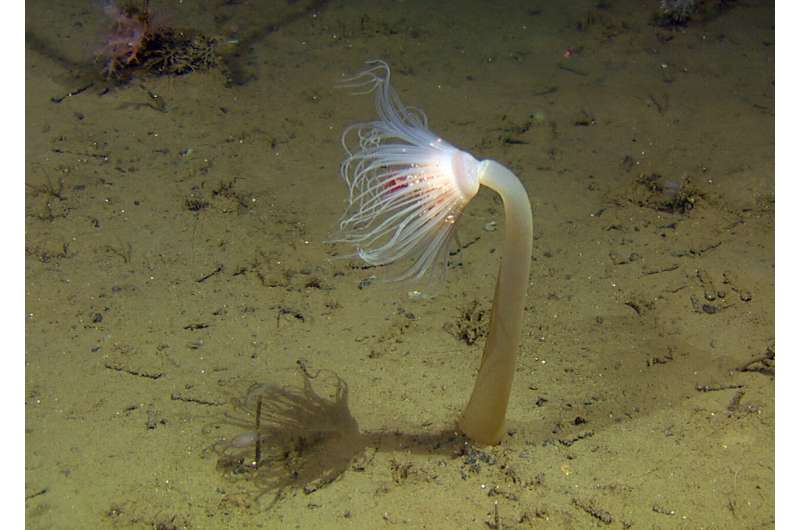The world's continental shelves are peppered with undersea oil wells. Once they are no longer in use, someone will have to monitor them — but how? A group of NTNU graduate students has a possible answer. Credit: Colourbox
The coastline of Norway is peppered with more than a thousand oil wells, most of which will be plugged once they're no longer profitable. They have to be monitored in case they leak—but keeping an eye on them isn't easy. A new company offers a different approach that could help.
Subsea surveillance poses many challenges, including communication between water and land. Wireless communication through water works poorly over long distances, so today's alternative is to communicate through cables. Placing cables in the ocean can be very expensive, though, so alternative solutions are of interest.
Now, a company started by three graduate students from the Norwegian University of Science and Technology (NTNU) is developing a new approach that can help researchers and companies send and receive information from their subsea installations. The company is called Ocean Access and was started as a master's project at the NTNU School of Entrepreneurship.
"Imagine that a sensor at the bottom of the ocean has detected a possible gas leak from a closed down oil field, but that the gas bubbles were really created by a fish. We need a system that cannot only discover leaks, but that can also verify them," said Andreas Mauritzen, one of the company's co-founders.
Complicated communication
Wireless communication works well on land, but all existing subsea solutions have their disadvantages. One of the key challenges is something called bandwidth.
The bandwidth is the difference between the highest and the lowest frequency that a signal consists of. A signal with a large bandwidth can contain more information than a signal with smaller bandwidth.
"You can send signals wirelessly through water with acoustic communication. Then you get a long range, but the narrow bandwidth is problematic. With acoustic communication, you can send a simple "OK' signal, but not larger datasets such as photos or videos. " Mauritzen said.
"Optical communication is another existing solution for sending data through water. There you get a large bandwidth but a low range," he said.
In other words, with today's technology, you cannot send larger data files wirelessly over large distances under water. A signal can be sent between water and land through cables, but this is costly. However, by transferring the information by cables through water and wirelessly through air, the students hope to create an effective communication system.
The possibility of sending larger data files, such as photos and videos, is one of the company's main goals.
Periodic information transmission
The new company's approach involves two steps. First, a data collecting unit is released from an installation at the bottom of the ocean. It trails a long cable all the way to the surface.
This model shows a simplified version of the system Ocean Access is developing. Data will be collected from this kind of installation by an autonomous underwater vehicle (AUV) or by a surface vessel. Credit: Ocean Access
Then, the information will be sent from the ocean surface to land through the air, via satellites or 4G.
When the job is done, the small device will be winched back via the cable to its subsea installation. The cable will be pulled back to the bottom along with the device, similar to a reversed yo-yo where the subsea installation corresponds to the thrusting hand.
Protected against storms and marine traffic
The information-sending device will be programmed to leave the sea floor periodically, or whenever the sensors register abnormally high values. Most of the time, the system will be protected on the ocean floor and will not be exposed to big waves or stormy weather, like it would if it was placed on the surface permanently. Bringing it to the surface from its ocean-bottom home only when needed, also means it can't be damaged by ships.
In many areas, the device will have to travel several hundred meters up to reach the surface. The students say that a cable of 400 meters will allow them to monitor most temporarily abandoned subsea wells on the Norwegian continental shelf. However, over the long term, the founders hope their device will be able to work even deeper.
"At 400 meters below the sea surface, we will reach practically all of these wells in Norway. But we are just getting started, so 400 meters is deep enough for the time being," Mauritzen said.
Many possibilities
Mauritzen and his co- founders, Fredrik Lilleøkdal and Morten Skogly, envision several uses for the device they are developing. One could be to monitor temporarily plugged oil wells. Since undersea oil fields that are no longer in use can develop leaks, the Norwegian government requires companies to keep them under surveillance. Similarly, the technology can be used to look after fish farms and, over time, subsea carbon storage reservoirs.
Another potential application is ocean research. The three entrepreneurs predict more and more marine research in the coming years. A device like the one they are developing can be stationed in the ocean and collect large datasets from the same location over time.
That way, it will be possible to monitor variables such as oxygen levels, pH and temperature. It will also be possible to connect other types of sensors to the device so that the user can measure whatever parameter they wish.
Power supply a challenge
One of the biggest challenges the company faces is providing power to their device. There are no power outlets on the ocean floor, after all, and the device will need power to collect and transmit data. It will also be stationed on the ocean bottom for long periods, which means the power supply will need to be durable and long-lasting.
For now, the system is being designed to be powered solely by a large battery pack. Later , the entrepreneurs think the solution is to combine the battery with a renewable energy source that can generate its own electricity. One possibility is to use a power generator driven by ocean currents.
Many parts of the device, such as cameras and sensor equipment, can be purchased from external producers. However, the students will have to construct the electricity generator themselves. The reason for this is that the already existing devices are too big. The system they are developing will only need to provide itself with a small power supply, sufficient for periodic data collection.
A giant hydroid, Corymorpha hydrozoa (from 1000-1500 m deep), from a headland west of Andøya, an island north of Narvik, in northern Norway. There’s increasing interest in exploring the ocean bottom, and the Ocean Access team hope their technology can help expand this exploration. This photo was taken in association with a major Norwegian sea bottom mapping project called Mareano. Credit: Mareano / Institute of Marine Research
Ups and downs
The first six months after the company was started were solely used to collect feedback and advice from different experts and potential customers. The concept was continually adjusted and improved. Skogly describes it as going eight steps backwards for every second step forwards.
In the autumn of 2019, the students discovered a key point: their customers want a simple solution so that the chance of unexpected problems is minimized. At the same time, their idea started winning prizes. All told, the students and their idea have won more than NOK 350 000, or about EUR 35 000.
One of the prizes was given to them by the energy company Equinor and NTNU Energy Transition Initiative. Equinor might become one of Ocean Access's biggest customers in the future, and their feedback on the project has been invaluable. The students even met with Eldar Sætre, president and Chief Executive Officer of Equinor, which added to their motivation.
The students are using the money they've won to build a prototype, develop graphical illustrations of the product and cover costs related to patent applications.
The road ahead
The entrepreneurs also have other financing sources in their sights: The Research Council of Norway has a special pot of money that could provide as much as NOK 1 million.
Recently, Ocean Access began working with Kongsberg Innovasjon, a company that offers free expertise and aid to a few chosen entrepreneurs and small businesses.
A product there is a demand for
Even Haug Larsen, Project Manager and Assistant Professor at NTNU School of Entrepreneurship, says there's good reason the three students have gotten as far as they have.
"Ocean Access has done well in understanding which problems to solve for whom. They have investigated different solutions to the problem and have been flexible," he said. "For a business to succeed, you need a good team, a good product and a good market. Of these three, I would say the market is most important. Ocean Access is creating a product there is a demand for."
Why is underwater monitoring so hard?
- Norway's ocean area as defined by the exclusive economic zone, or 200 nautical miles off the coastline, is approximately five times larger than its land area.
- The ocean covers 70.8% of the Earth's surface.
- Almost 60% of the Earth's surface exists at more than 2000 meters below sea level.
- About 95% of the ocean water masses have never been seen by humans.
- Since production started in 1971, oil and gas have been extracted from more than 100 oil fields on the Norwegian continental shelf.
- Carbon capture and storage (CCS) is a technology that captures, transports and stores the greenhouse gas CO2 below the ground.
- The UN has listed CCS as a necessary means to reach the 2-degree climate goal.
Provided by Norwegian University of Science and Technology

























